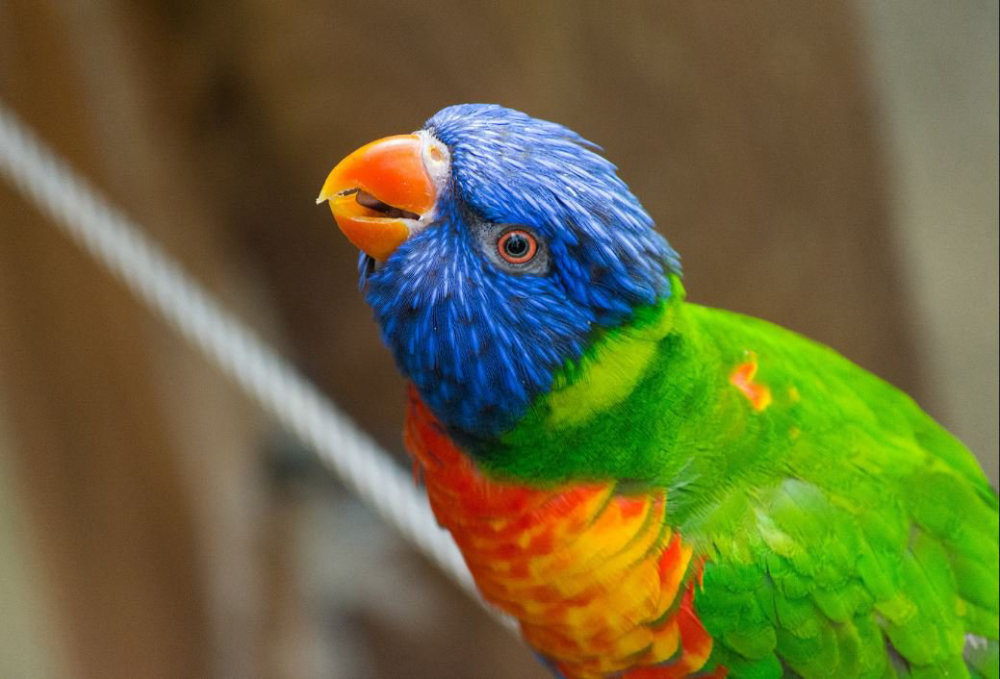In the realm of avian beauty, few creatures rival the resplendent elegance of the Rainbow Lorikeet (Trichoglossus moluccanus). With its kaleidoscopic plumage and charismatic personality, this Australian parrot species has captivated the hearts of bird enthusiasts worldwide. From its vibrant colors to its playful antics, the Rainbow Lorikeet embodies the essence of nature’s artistic brilliance. Let’s embark on a journey to explore the fascinating world of these feathered wonders.
Anatomy and Appearance
The Rainbow Lorikeet is popular for its striking appearance, characterized by a flamboyant display of colors. Its plumage features a mesmerizing palette of green, blue, yellow, orange, and red, arranged in intricate patterns across its body. These vivid hues serve not only as a visual feast but also as a form of camouflage in its natural habitat of dense forests and woodlands.
One of the most distinctive features of the Rainbow Lorikeet is its brush-tipped tongue, perfect for feeding on nectar and pollen. This adaptation allows them to extract the sweet nectar from flowers with remarkable efficiency, making them important pollinators in their ecosystems. Additionally, their strong beaks are well-suited for cracking open seeds and nuts, providing a diverse diet that includes fruits, berries, and insects.
Behavior and Social Structure
Beyond their striking appearance, Rainbow Lorikeets are renowned for their lively and sociable nature. These gregarious birds are often found in flocks, engaging in playful interactions and vocalizing with a cacophony of squawks, chirps, and screeches. Their raucous calls echo through the treetops, serving as a testament to their exuberant presence.
Within these flocks, Rainbow Lorikeets form strong bonds through mutual grooming and cooperative foraging. They exhibit a complex social structure, with hierarchies established through subtle displays of dominance and submission. Despite occasional squabbles over territory or resources, these birds generally maintain harmonious relationships within their communities.

Breeding and Reproduction
During the breeding season, which typically occurs from August to January in Australia, Rainbow Lorikeets engage in elaborate courtship rituals to attract mates. Males showcase their vibrant plumage and perform intricate aerial displays to impress potential partners. Once there is a pair bond, they work together to build a nest in a hollow tree cavity, using twigs, leaves, and other materials.
After mating, the female lays a clutch of 2-3 eggs, which she incubates for approximately three weeks. Both parents take turns caring for the eggs and feeding the hatchlings, demonstrating remarkable parental dedication. Within a few weeks, the chicks fledge from the nest, although they may remain dependent on their parents for several more weeks as they learn essential survival skills.
Conservation Status and Threats
While Rainbow Lorikeets are currently widespread and abundant throughout their range, they face several threats that jeopardize their long-term survival. Habitat loss due to urbanization, deforestation, and agriculture poses a significant challenge, depriving them of essential nesting sites and food sources. Additionally, competition with introduced species, such as European honeybees and other parrot species, further exacerbates their plight.
Furthermore, illegal trapping for the pet trade and poaching for their colorful feathers continue to pose significant threats to wild populations. Despite legal protections in place, enforcement remains challenging, allowing illegal activities to persist. Conservation efforts aimed at habitat preservation, captive breeding programs, and public awareness campaigns are essential for safeguarding the future of these charismatic birds.
Conclusion
In conclusion, the Rainbow Lorikeet stands as a testament to the breathtaking diversity of the natural world. With its vibrant plumage, lively demeanor, and important ecological role, this iconic parrot species enriches the ecosystems it inhabits and brings joy to all who encounter it. As stewards of the environment, it is our collective responsibility to ensure that future generations can continue to marvel at the beauty of the Rainbow Lorikeet in the wild. Through conservation efforts and appreciation for the wonders of nature, we can preserve this living masterpiece for generations to come.









